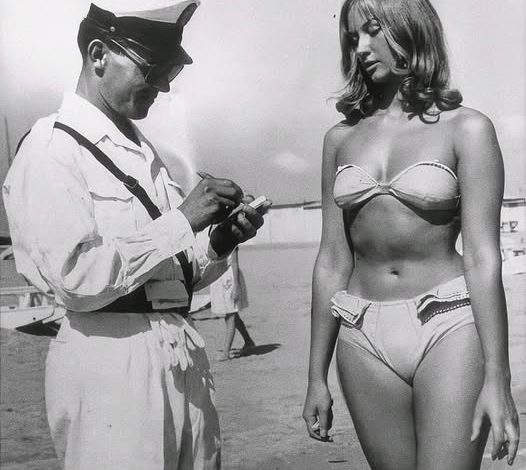
At first glance it looks like a harmless photo of a woman on the beach but look closer and you will see the hidden detail
What seems like a carefree image of a woman in a bikini on the beach carries with it a deep, turbulent history—one of controversy, rebellion, and cultural evolution. That tiny garment, barely visible in a photo, once ignited outrage, sparked bans, and led to arrests around the world. But it also became a symbol of empowerment, challenging the boundaries of decency and reshaping the way society views women’s bodies and freedom.
In the early 20th century, swimwear looked nothing like it does today. Designed to protect modesty above all else, women wore heavy woolen garments that extended from the neck to the knees. Beaches across America enforced strict dress codes, with tailors stationed to quickly add fabric to exposed skin. In Chicago, officials measured swimsuits for compliance. In Washington, D.C., beach police patrolled with tape measures. In New York, bathing socks that exposed a woman’s knees were banned.
But rebellion was already stirring.
In 1907, Australian swimmer Annette Kellerman defied convention by wearing a one-piece swimsuit that showed her arms, legs, and neck. Though reports of her arrest remain debated, her boldness made headlines. The “Australian Mermaid” later launched her own swimwear line, marking the beginning of swimwear as both a statement and a choice.
The 1920s brought a wave of cultural change. Flappers challenged traditional roles, and beachwear followed. In California, the “skirts be hanged” movement called for swimsuits that allowed real movement, not just modesty. Swimsuits became more form-fitting, and the idea of practicality over propriety began to take hold.
But it was in 1946 that the swimwear world was truly shaken.
Louis Réard, a French engineer, introduced the bikini—a two-piece swimsuit that exposed the navel and more skin than any design before it. Named after the Bikini Atoll, the site of a U.S. nuclear test just days earlier, Réard claimed the impact of his creation would be just as explosive. He was right. The bikini was instantly banned in several countries, condemned by the Pope, and branded immoral by conservative regimes across Europe.
Photos from the era show police confronting women on beaches, ticketing or even removing them for “indecency.” In Italy, an iconic photo captured a uniformed officer beside a bikini-clad woman, symbolizing the tension between control and liberation. Though the specifics of that moment remain unclear, its message was universal: wearing a bikini was a bold, even dangerous, act.
Through the 1950s and into the 1960s, resistance persisted. Films were censored under Hollywood’s Hays Code, which forbade exposed navels. Groups like the National Legion of Decency lobbied hard against the growing popularity of revealing swimwear.
But cultural icons refused to back down. Marilyn Monroe posed confidently in two-pieces. Brigitte Bardot’s sun-soaked elegance in The Girl in the Bikini redefined sensuality. And Ursula Andress’s unforgettable ocean scene in Dr. No transformed the bikini into a global symbol of power and confidence.
By the 1970s, what had once been taboo was now mainstream. Bikinis shrank further, string styles emerged, and even men’s swimwear became more revealing. What had begun as a tool of control—what women could and couldn’t wear—had been reclaimed as a form of personal expression.
Today, the conversation around swimwear is no longer about modesty versus immorality. It’s about choice, identity, and comfort. Whether you wear a full-coverage one-piece, a sporty rash guard, or a barely-there bikini, the message is the same: wear what makes you feel powerful.
That beach photo, at first glance, may look like just another day in the sun. But in truth, it represents over a century of women fighting for the right to be seen, to be heard, and to be free—on their own terms.




